This sourdough baguette is everything you want in the French classic–a crunchy crust, an open, airy crumb, and lots and lots of flavor. And it's easier to make than you think! Eat it plain, slathered in butter, or serve it with your favorite soup. For best results, this recipe requires sourdough starter, kitchen scale, a baguette pan and 3 days. See all our sourdough recipes here!
How to make Sourdough Baguettes! By now, many of you have perfected your Easy Sourdough Bread, and I thought I’d share a recipe for Sourdough Baguettes that will introduce a couple of new terms and techniques to add to your growing repertoire. This recipe was created by my friend, Kris Osborne, over at Baked- the blog.
She’ll introduce you to the terms “levain” and “autolyse”, two things I intentionally omitted from the Sourdough Bread recipe to keep it as simple as possible. But I know you are ready now! You’ll recognize the stretch and fold technique and will have, by now, be able to do this with your eyes closed. I’m so excited for you to try this. Keep in mind this recipe takes 3 days.
How to make Sourdough Baguettes| step-by-step Video
Sourdough Baguette ingredients
- Active, bubbly starter (make sure it doubles within 6 hours of feeding)
- Bread flour -try for organic, locally milled, if possible. 🙂
- Salt
- A scale
- Baguette Pan
STEP ONE: The night before you plan to make the baguette dough, make the levain: In a medium bowl, mix together the starter, water, and bread flour until well-combined. Cover with a plate and rest overnight (8-12 hours) until very bubbly and active.

The levain should have many small bubbles across the top and throughout.
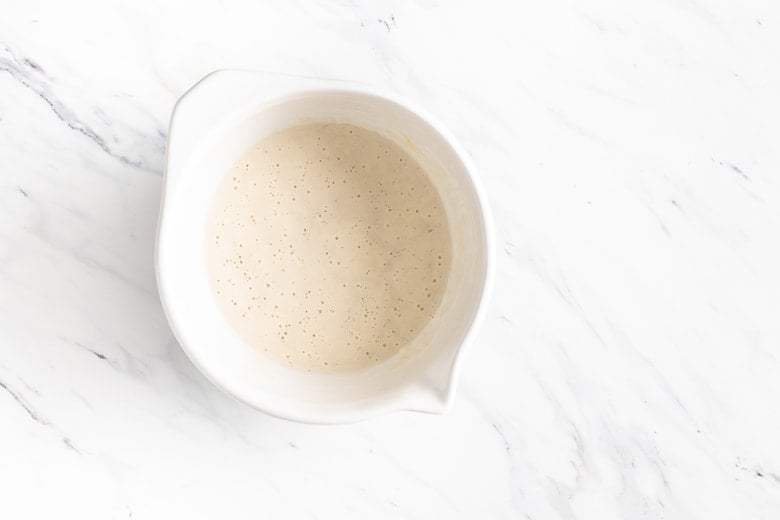
STEP TWO: Day two, morning. Transfer all of the levain to a large bowl. Add the water and bread flour, and mix until all of the flour is incorporated and a shaggy dough is formed. Cover with a lid or damp towel and set aside 45 minutes to rest. This is called the autolyse.
STEP THREE After the 45-minute rest period, add the salt to the dough and squeeze and pinch the salt into the dough until evenly distributed. Perform a set of stretch and folds (see notes), then cover and set aside for 30 minutes to rest.
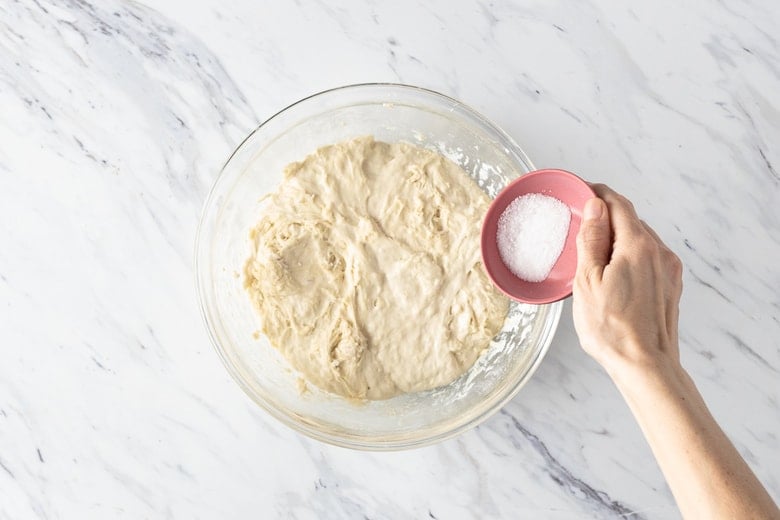
STEP FOUR: Continue to perform a set of “stretch and folds” every 30 minutes for 3 hours, covering and resting in between each round.
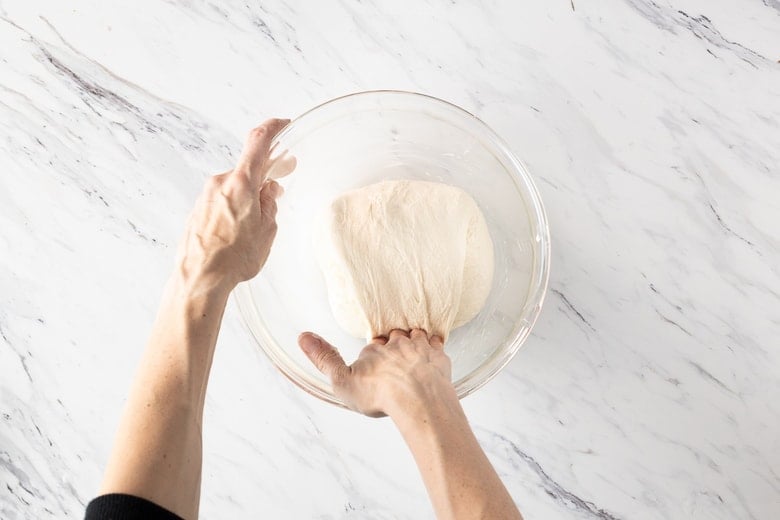
How to do the Stretch and folds
To perform a series of stretch and folds, imagine the dough in 4 quadrants. Grab the dough in the 12 o'clock position and pull it up and over toward yourself (toward the 6 o'clock position). Watch the video above.
Then, rotate the bowl a quarter turn to the right and grab the dough in the 12 o'clock position again (formerly 9 o'clock), bringing it up and down toward 6 o'clock once more. Repeat this step 2 more times until each quadrant of the dough has made it to the 12 o'clock position and has been stretched and folded onto itself.
The dough will look like a little parcel.
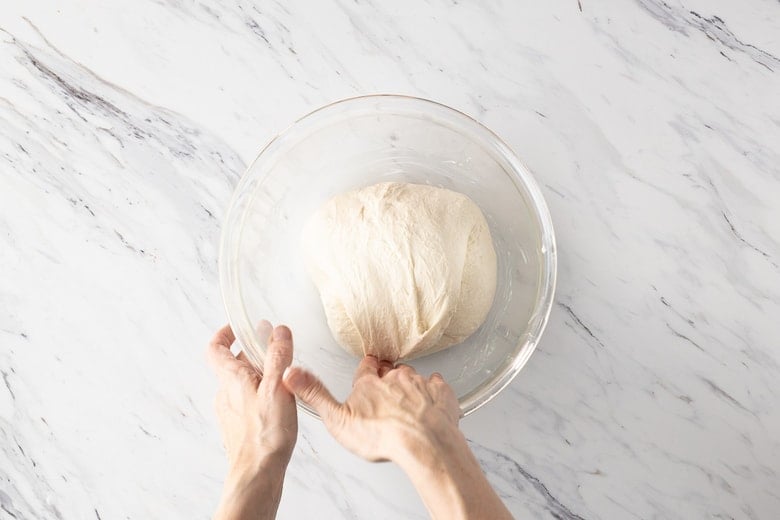
STEP FIVE Shape! Gently tip the dough onto a lightly floured surface and cut it into 3 equal portions. Using a circular cupping motion with the palm of your hand, gently roll each ball of dough on the countertop to create a taut ball.
Gently dust with flour and cover with a towel. Bench rest 30 minutes.

Sprinkle your countertop with flour and gently pat the first ball of dough into a rectangle, approximately 9 inches long. Fold the top third of the dough down (like folding a business letter) and press it into the dough, using the heel of your hand, to stick the edges together.
Rotate the dough 180 degrees and repeat so that both the bottom and top thirds have been folded in. Fold the dough in half once more to create a slim silhouette, and, again, use the heel of your hand to connect the edges. Roll the dough so it's seam-side down and press and roll the dough out so that a baguette shape forms, pinching the edges to taper them, if necessary.
Place seam side down on a greased baguette pan or on floured parchment-lined sheet pan. Please refer to video above!
STEP SIX. Cover with plastic wrap and refrigerate overnight, anywhere from 14-18 hours. This is the long proof.
TIP: Take note of the time so you can adjust next time. In the morning, the dough will have expanded by 70-80% (this is the goal). 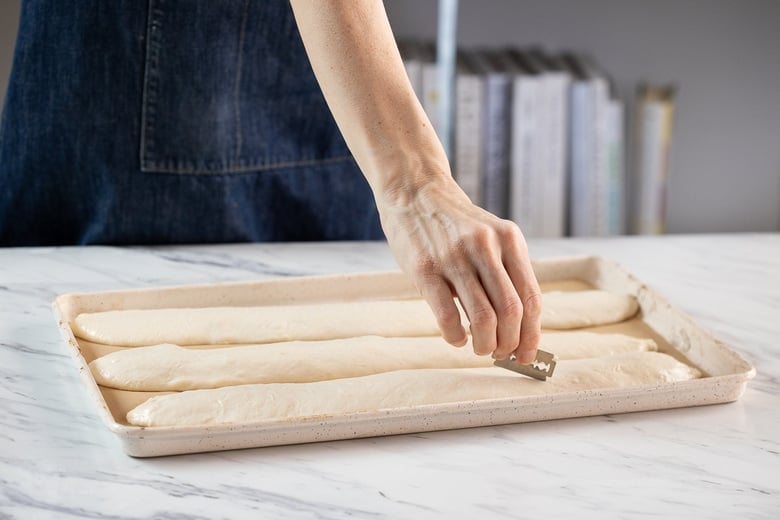
STEP SEVEN. Day 3: The next morning, preheat the oven to 500°F (260°C) with the oven racks positioned in the middle and one level below.
Bake the baguettes directly on a baking sheet or the baguette pan. Keep in mind, the baguette pan will leave slight perforations on the bottom of the bread.
Score. Using a lame (or sharp knife or razor blade), make 3-5 diagonal slashes into each piece of dough.
Step 8: BAKE. Place a handful of ice cubes onto the second baking sheet. Immediately place the baguette dough into the oven on the middle rack and place the baking sheet with ice on the rack below. Close the oven door and turn the temperature down to 450°F. Bake for 30 – 35 minutes, or until the bread is a deep golden brown.
Remove from the oven and cool completely on a wire rack before cutting.

How to store Baguettes
Bread is best eaten on the day that it's made, but if stored in paper will keep an additional day.
You can freeze baguettes, sliced or whole. If slicing, freeze individual slices on a baking sheet, then place into a freezer bag. If freezing whole, wrap tightly with aluminum foil or plastic freezer wrap, then place in a freezer bag. Bread will keep this way for a few months.

Troubleshooting
- Make sure your sourdough starter is active and happy. The starter should double within 6-8 hours of feeding. Read through our sourdough starter recipe for more details.
- The bulk rise time will vary depending on your starter and your fridge temp. The goal is 70-90% expansion. In the morning, do the poke test: let the dough come to room temp. Flour a finger and poke the dough. If it springs back quickly, it may be underproofed. If it doesn’t spring back, it is likely overproofed (bake it anyway!). If it springs back slowly, it is just right.
Enjoy the process of learning how to make Sourdough Baguettes and let us know how it goes! Take a peek at all our sourdough recipes!
Happy Baking!
More Favorite sourdough recipes
- Jalapeño Cheddar Cheese Sourdough Bread
- Simple Sourdough Starter
- Sourdough Pizza Crust
- No-Knead Sourdough Bread
- Rosemary Olive Sourdough Bread
- Sourdough Crackers
- Vegan Banana Bread
- Overnight Sourdough Waffles
- Sourdough Pancakes
- Sourdough Scones
- Sourdough Biscuits
- Sourdough Buns
- Sourdough croutons
Love baking? You might also like our Homemade Pie Crust recipe!

Sourdough Baguette Recipe
- Prep Time: 36 hours
- Cook Time: 35 mins
- Total Time: 36 hours 35 minutes
- Yield: 3 14-inch baguettes 1x
- Category: bread, sourdough, baked
- Method: baked
- Cuisine: French
- Diet: Vegan
Description
This sourdough baguette is everything you want in the French classic–a crunchy crust, an open, airy crumb, and lots and lots of flavor. And it’s easier to make than you think! Eat it plain, slathered in butter, or serve it with your favorite soup. For best results, this recipe requires a kitchen scale, a baguette pan and 3 days time!
Ingredients
- 65 grams active bubbly starter
- 65 grams tepid water
- 65 grams bread flour
- 420 grams tepid water
- 600 grams bread flour
- 12 grams salt
Instructions
Day 1: (Evening) Levain
Make the levain: In a medium bowl, mix together the starter, water, and bread flour until well-combined. Cover with a plate and rest overnight (8-12 hours) until very bubbly and active. The levain should have many small bubbles across the top and throughout.
Day 2: Mix, stretch and folds, shape, bulk rise overnight.
- Mix. In the morning, transfer all of the levain to a large bowl. Add the water and bread flour, and mix until all of the flour is incorporated and a shaggy dough is formed. Cover with a lid or damp towel and set aside 45 minutes to rest. This is called the autolyse.
- Salt, stretch and fold. After the 45-minute rest period, add the salt to the dough and squeeze and pinch the salt into the dough until evenly distributed. Perform a set of stretch and folds (see video), then cover and set aside for 30 minutes to rest. Continue to perform a set of stretch and folds every 30 minutes for 3 hours, covering and resting in between each round.
- Divide. Gently tip the dough onto a lightly floured surface and cut it into 3 equal portions. Using a circular cupping motion with the palm of your hand, gently roll each ball of dough on the countertop to a create a taut ball. Gently dust with flour and cover with a towel. Bench rest 30 minutes.
- Shape. Sprinkle the countertop with flour and gently pat the first ball of dough into a rectangle, approximately 9-inches long. Fold the top third of the dough down (like folding a business letter) and press it into the dough, using the heel of your hand, to stick the edges together. Rotate the dough 180 degrees and repeat so that both the bottom and top thirds have been folded in. Fold the dough in half once more to create a slim silhouette, and, again, use the heel of your hand to connect the edges. Roll the dough so it’s seam-side down and press and roll the dough out so that a baguette shape forms, pinching the edges to taper them, if necessary.
- Bulk rise. 14-18 hours. Place them seam side down on a greased baguette pan or heavily dusted, parchment-lined sheet pan. Cover with plastic wrap and refrigerate overnight 14-18 hours.
Day 3: Morning. Preheat, score and bake!
- Preheat. The next morning, preheat the oven to 500°F (260°C) with the oven racks positioned in the middle and one level below. Have a baking sheet ready to add ice cubes to. (See notes.)
- Score. When the oven is hot, remove the baguette dough from the fridge. Using a lame (or sharp knife or razor blade), make 3-5 diagonal slashes into each piece of dough (¼-½ inch deep).
- Bake. Place a handful of ice cubes onto the second baking sheet. Immediately place the baguette dough into the oven on the middle rack and place the baking sheet with ice on the rack below. Close the oven door and turn the temperature down to 450°F. Bake for 30 – 35 minutes, or until the bread is a deep golden brown. Remove from the oven and cool on a wire rack.
Notes
Stretch and folds: To perform a series of stretch and folds, imagine the dough in 4 quadrants. Grab the dough in the 12 o’clock position and pull it up and over toward yourself (toward the 6 o’clock position). Then, rotate the bowl a quarter turn to the right and grab the dough in the 12 o’clock position again (formerly 9 o’clock), bringing it up and down toward 6 o’clock once more. Repeat this step 2 more times until each quadrant of the dough has made it to the 12 o’clock position and has been stretched and folded onto itself. The dough will look like a little parcel.
Baking: When transferring the cold baguette dough to a parchment-lined pan, it will be snake-ish and hard to work with. Move quickly and efficiently so you don’t disrupt the shape of the baguette too much. Alternatively, you can bake the baguettes directly on the baguette pan until you get more comfortable working with the dough. Keep in mind, the baguette pan will leave slight perforations on the bottom of the bread.
Steam: Create steam by placing ice cubes on a sheet pan on the lowest rack, under the baguettes.
Storage. Bread is best eaten on the day that it’s made, but if stored in paper will keep an additional day. You can freeze baguettes, sliced or whole. If slicing, freeze individual slices on a baking sheet, then place into a freezer bag. If freezing whole, wrap tightly with plastic freezer wrap, then place in a freezer bag. Bread will keep this way for a few months.
How to tell if the dough is proofed long enough? Do the poke test: let dough come to room temp. Flour a finger and poke the dough. If it springs back quickly, it may be underproofed. If it springs back slowly, it is just right. If it doesn’t spring back, it is likely overproofed (bake it anyway!).
Nutrition
- Serving Size: ¼ of a baguette
- Calories: 196
- Sugar: 0.2 g
- Sodium: 388.7 mg
- Fat: 0.9 g
- Saturated Fat: 0.1 g
- Carbohydrates: 39.3 g
- Fiber: 1.3 g
- Protein: 6.5 g
- Cholesterol: 0 mg







Hi thank you for the receipt. I made my starter early in the day and won’t be able to mix all ingredients until the next morning , is it ok to put the starter in the fridge or will I have to start it all over to stay active?
I think it should be fine in the fridge!
Beautifully tasty baguettes so airy!
Great to hear Candice~ Congratulations!
Hi there!
Maybe it’s just me, but the video link doesn’t seem to be live. Made the dough this morning! Excited to go the process.
Hi Leisel, I’m excited for you! Are you using an ad-free browser, or have ad-blocker turned on? That will shut off the video.
This recipe makes 3 baguettes can it be reduced to make just one (single lady here) or can the shaped dough be frozen prior to baking? I’ve frozen sourdough cinnamon rolls the baked them from frozen and feel they bake up better than from fresh.
Thank you ☺️
Hi Cynthia, yes the dough can be shaped and frozen. Perfect for meal prep!
I’m about to try this recipe, and I’m really excited! But I have a question on the timing:
If I’m starting Day 2 in the morning, Step 6 (refrigerating overnight) would begin around 2 or 3 pm.
Is it OK if the bulk rise phase in the fridge lasts for more than 12 hours? I don’t want to get up at 2 am to bake them. 🙂 ha
Thanks!
Hi Jenn, yes this is fine if over 12 hours. 14-18 hours is typical!
I do consider myself an experienced baker even with sourdough and I have made yeast baguettes before very successfully. These did not rise in the fridge even though I left them for 48 hours. They rose a bit in the oven but not as they should.Having said that the taste, texture & crunch were pretty perfect so I gave mine a 9/10 (always rate my recipes) I just need to do a bit of work on the recipe. A bit less water or more flour because as we know different flours act differently, so thank you so much for sharing
Hi Annie, I’m glad you enjoyed this flavor and texture. wonder if most of your rising happened before they went in the fridge- which can happen during the warmer months?
Hi Sylvia
I am in South Australia and it is winter here, and I put the shaped dough in the fridge as soon as I finished the stretch and folds, so I don’t think that was the issue. I do think however my fridge is quite cold at 2° and that could be a problem with this particular dough
That could be it. Try pulling them out a couple hours before baking.
Thanks Sylvia
I had more than 1/3 of the dough left in the fridge so this morning I added 1/2 Tspn instant yeast, re-worked it with some extra flour and hopefully it will rise well this time. I should have used my judgement though because I knew the dough was too soft and of course what we do know is that flours can vary so much from country to country and even state to state. Wish I could send you a photo if it works out. Not so much if it doesn’t. Haha
Great Annie- thanks for the update!
So all went to plan. It did swell and flatten during the rise out of the fridge, but once in the oven it popped up beautifully and was pretty perfect, so once again thank you
Great to hear Annie!
ok so I tried to make 2 instead of 3 and they ended up being way too dense. What could have caused this. should i let them rise a bit outside of the firidge
in the morning before putting it in the oven?
Shoot Kristina, it may have been the bigger size needed longer to rise? Yes, you could try leaving them out.
Can you make 2 large baguettes if using a baguette specific pan or will they end up being just too big?
Hey Kristina- they will be quite big but it’s worth a try? Baking time will need to be extended.
It did not get much bigger and not very fluffy seems a little under cooked but good flavor first time baker
Glad the you enjoyed the flavor! Check that your starter is nice and active, and add a few minutes time to baking next time! It takes a few times to perfect this. 🙂
Hi! So I’m still learning, does this recipe not need a bulk fermentation or is that what’s happening during stretch and folds?
Hi Amanda, yes it does need it. The bulk fermentation is happening both with the stretch and folds, and with the overnight rise in the fridge.
wow-this is amazing! Comes out great every time. I divide into four instead of three–keep everything else the same (usually bake about 28min in my oven.) That way i give three away to friends or family–they LOVE them! (I could eat them all myself–but need to watch the calories 🙂 )
Thanks Stan! Appreciate your helpful review. 🙂
Hello. I am new to baking breads with sourdough. This recipe was easy to follow and the end result was delicious. Will definitely be making these again.
So happy this worked out for you!
Hello Sylvia I made a mistake and added the salt at the same time as the flour, water and levain. What issue am I going to have?
Hi Kurt! The salt could affect the rise- slow it down, or perhaps even lessen it… but not always. At this point I would just carry on and hope for the best!